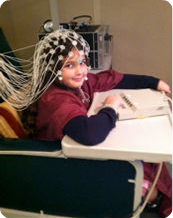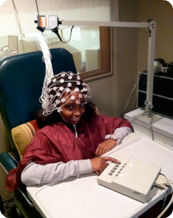




Who are we?
We are research scientists interested in the development of complex cognitive skills, particularly those used for executive control processes (e.g., inhibition, monitoring performance for errors), in typically developing children and in children with specific language impairment (SLI).
What do we do?
We conduct studies to examine the development of complex cognitive skills in children ages 6-12. Testing is conducted over two sessions. In one session, we administer standardized language and non-verbal intelligence tests. The results of these measures indicate how a child’s language skills and non-verbal intelligence compare to those of other children of the same age. In a second session, we record event-related potentials (ERPs), which refer to the electrophysiological activity of the brain associated with cognitive processes. ERPs are recorded while the children play computer games for which they earn prizes commensurate with their performance. The two sessions may be conducted on the same day or on two separate days, depending on a child’s abilities and preferences and based on availability of appointments.
What are event-related potentials (ERPs)?
When information is processed, the neurons of the human brain alter the flow of electrical currents. The changing currents produce electric and magnetic fields. By placing probes called electrodes on the surface of the scalp, these electric fields can be measured non-invasively. The small changes in voltage, or electrical potentials, among various electrodes are amplified and then recorded.
The continuous electrical activity in the brain is referred to as the electroencephalogram, or EEG. The EEG contains a signal that informs us about brain processes, such as those involved in reading or listening to sounds. The signal is extracted from the EEG by time-locking the recording of the EEG to the onset of events of interest (e.g., images presented on a computer monitor). The activity in the signal is called an event-related potential because it is the electrical activity related to processing of a specific event. Typically, ERPs are collected in a laboratory that includes specialized software and hardware, including computers, amplifiers, and electrode hair nets. While wearing the electrode hair net, stimulus events are presented to the subject and the EEG is recorded and digitized by a computer. The recorded data then undergo signal processing to remove noise, which is activity that is not related to the event of interest. To ensure a good signal to noise ratio, multiple presentations of each stimulus type are typically presented and the trials are then averaged together to decrease the impact of the non-event related EEG.
Informative parts of the ERP waveforms are referred to as components and appear as positive and negative-going fluctuations over time. These components represent brain activation that is associated with one or more mental operations. Time-locking the EEG to stimuli of interest thus enables researchers to identify psychological processes engaged in complex cognitive, perceptual, and motor tasks. For example, a researcher might employ the ERP methodology to study the brain processes involved in detecting errors during a button response task. ERPs provide multi-dimensional online information, including measures of polarity (negative or positive potentials), latency, amplitude, and spatial distribution across the scalp. Most notably, ERPs provide rich temporal information with exceptionally high time resolution down to the millisecond level!
What does ERP testing involve?
ERP testing in our lab takes place in a child-friendly environment. The entire procedure is SAFE and there is NO RISK OF PERSONAL INJURY. First, a child’s head size is measured to identify a hair net that will fit appropriately. The hair net comprises electrodes wrapped in soft sponges that rest gently on the scalp. Before applying the hair net to the child’s head, it is soaked in a mild salt water solution. No glue or adhesive material is used to attach the hair net to the child’s head. Once the hair net is applied, the child is seated on a comfortable chair in a sound-proof booth. A tray with a game-controller is placed in front of the child and the child is provided with instructions for a game that he/she completes while ERP data are collected. Frequent breaks are given during the experiment to allow the child to stretch his/her arms and legs.
Is there a fee for the testing?
No. Both sessions of testing are free.
What are the benefits of participating in this research?
Parents receive brief written reports about their children’s performance on the standardized tests. In addition, the children receive monetary compensation on an hourly basis, as well as small prizes commensurate with their performance. There is also a potential benefit to society if our research advances our understanding of typical language development and child language disorders.
Will my child’s data be made public?
Your child’s records will be maintained strictly confidential. A number will be assigned to your child, which will be used to refer to data and other information in place of using his/her name. The records will be stored in a locked file cabinet in a locked office accessible to the research staff involved in this study. Authorized research investigators of the United States Food and Drug Administration and the Department of Health and Human Services may audit the record keeping of this research study. Results of this study may be published but will NOT include any information that can identify your child.
